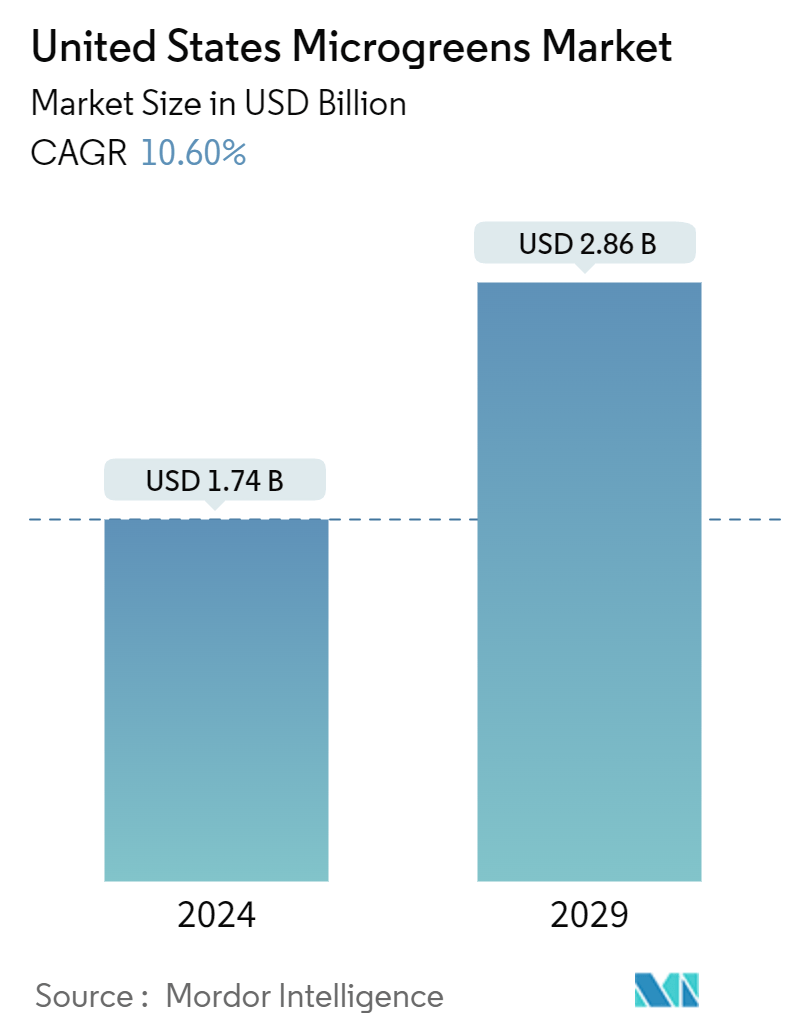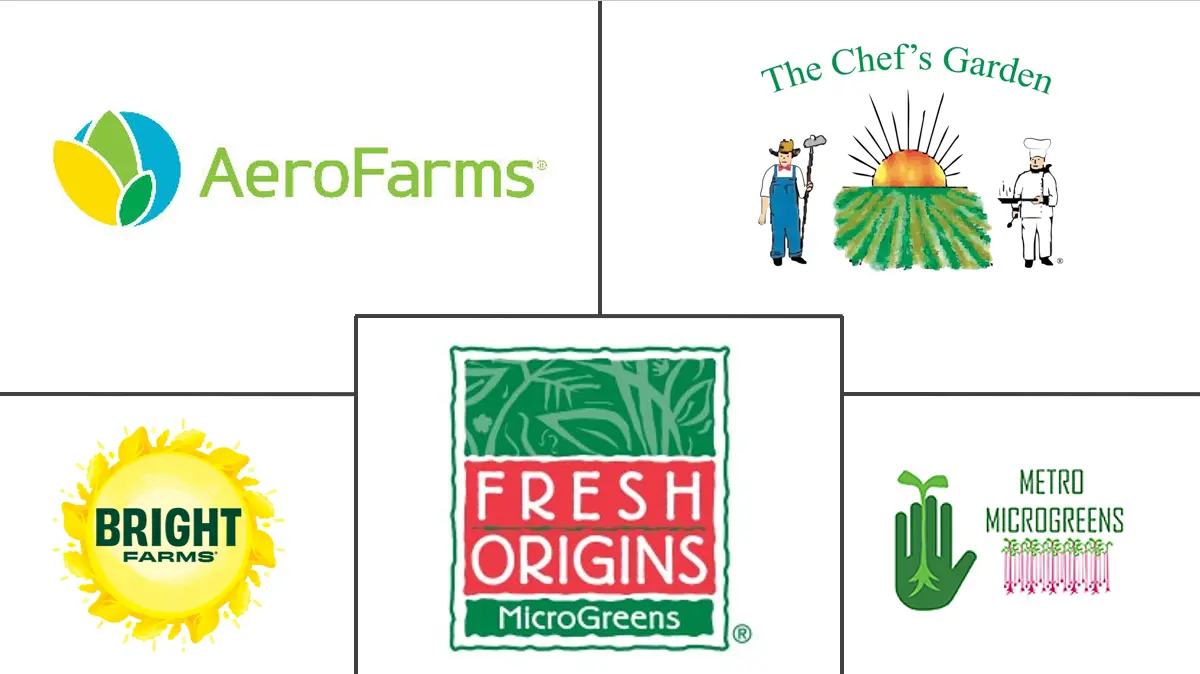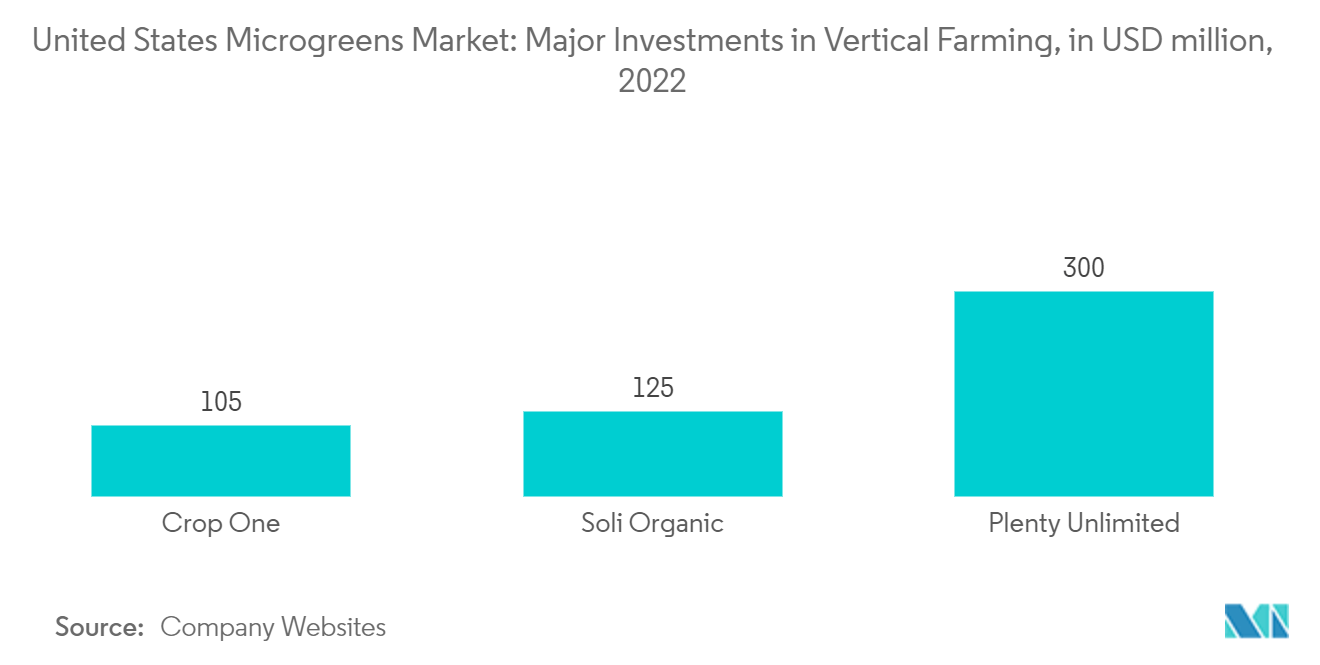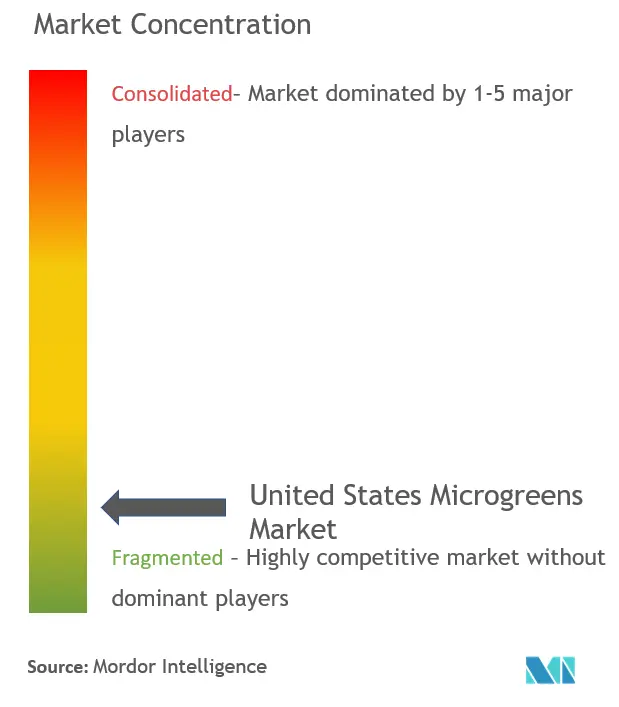United States Microgreens Market Size

| Study Period | 2019 - 2029 |
| Base Year For Estimation | 2023 |
| Market Size (2024) | USD 1.74 Billion |
| Market Size (2029) | USD 2.86 Billion |
| CAGR (2024 - 2029) | 10.60 % |
| Market Concentration | Low |
Major Players
*Disclaimer: Major Players sorted in no particular order |
United States Microgreens Market Analysis
The United States Microgreens Market size is estimated at USD 1.74 billion in 2024, and is expected to reach USD 2.86 billion by 2029, growing at a CAGR of 10.60% during the forecast period (2024-2029).
- Microgreens are a rich source of polyphenols and antioxidants that lower the risk of diseases like heart disease, Alzheimer's, diabetes, and certain cancers. For instance, a study by the University of Maryland College of Agriculture and Natural Resources (AGNR) and the United States Department of Agriculture (USDA) reports that microgreens are 40 times more nutritious than other vegetables. In addition, microgreens are gaining popularity as a new culinary ingredient in the country, and they are used to enhance salads or as edible garnishes to embellish a wide variety of other dishes, which aids their growth in the country. Based on ethnic classification, Caucasian and Asian consumers are the demographic groups that buy most of the microgreens at a higher rate than other demographic groups.
- Companies in the United States recognize the potential of microgreens and are venturing into growing microgreens in the country. For instance, in 2024, Cox Enterprises launched Cox Farms, a new venture that produces various types of microgreens, such as baby lettuce and baby spinach. Moreover, as the demand for microgreens increases in the country, indoor vertical farms are expanding to meet this need. For instance, in 2024, Vertical Harvest Farms secured financing to establish a 51,000 sq. ft hydroponic vertical farm in downtown Westbrook, Maine, to produce lettuce, petite greens, microgreens, and herbs. The project's primary goal is to prioritize local food consumption by delivering farm-fresh greens to consumers' fridges within 24 hours, ensuring maximum nutritional value retention.
United States Microgreens Market Trends
Increasing Adoption of Protected Cultivation is Expected to Boost the Market
Greenhouse adoption in the United States has increased steadily over the years. Owing to population and the subsequent demand for food, farmers are increasingly turning to high-tech solutions like greenhouse farming and vertical agriculture, given the limitations of arable land. Simultaneously, a rising health consciousness among consumers pushing for nutrient-rich diets is fueling the adoption of protected cultivation practices in the country.
The shift to greenhouse farming and vertical farming allows growers to have precise control over the cultivation environment, leading to more efficient management and, notably, increased yields in microgreens. Additionally, the controlled setting of protected cultivation can positively impact crop genetics, yielding healthier varieties. In contrast, traditional open-field cultivation exposes crops to risks from pests, locusts, and other wildlife, necessitating heavy pesticide use, a challenge largely avoided by greenhouse and vertical farming.
Pea shoots, kale, baby spinach, and a variety of other crops, including amaranth and bok choi, dominate the greenhouse landscape in the United States, aligning with the rising consumer appetite for these products. Key players like BrightFarms Inc., Soli Organic Inc., Plenty, and Fresh Origins are at the forefront of leveraging greenhouse structures for their microgreen crops in the United States. For instance, the "2022 Census of Agriculture - UNITED STATES DATA" revealed that 11,465 farms operate greenhouses for cultivating vegetables and fresh-cut herbs.

Increasing Demand for Microgreens from Health-conscious Consumers
The United States is witnessing a surge in interest in fresh, functional foods driven by a health-conscious consumer base. Microgreens, known for their rich polyphenol content, offer potent antioxidants, potentially lowering the risk of various diseases, including heart disease, Alzheimer's, diabetes, and certain cancers. According to the United States Department of Agriculture (USDA), 100 gm of green leaf lettuce microgreens contain low levels of fat, carbohydrates, and sugars while offering moderate amounts of protein and fiber. It consists of 15 kcal energy, 1.36 grams of protein, 1.3 grams of dietary fiber, and 95 grams of water.
The growing popularity of salads, especially Caesar salads and salad bars, is driving the increased consumption of lettuce and chicory microgreens in the region. For instance, according to data from the USDA, the per capita consumption of fresh romaine and leaf lettuce in the United States rose from 12.3 pounds in 2019 to 12.7 pounds in 2022. Furthermore, microgreens, including pea shoots, kale, baby spinach, and broccoli, are witnessing a surge in demand, especially from major food and retail chains, promising a sales trajectory in the coming years. Kale microgreens, a standout in the US market, are prized for their high antioxidant, amino acid, vitamin, and mineral content. These are widely incorporated in salads, sandwiches, omelets, and pizza and enjoy immense popularity, particularly in restaurant settings. For instance, over 134 stores across the United States offer microgreens for sale.

United States Microgreens Industry Overview
The US microgreens market is fragmented. Prominent players in the market are Charlie's Produce (Farmbox Greens LLC), Metro Microgreens, Fresh Origins, Bright Farms, The Chef's Garden Inc., and Aerofarms LLC. These major players are investing in new products and improvisation of products, expansions, and acquisitions for business expansions. Another central investment area is the focus on R&D to launch new products at lower prices.
United States Microgreens Market Leaders
-
Metro Microgreens
-
Fresh Origins
-
The Chef’s Garden Inc
-
Aerofarms LLC
-
Bright Farms Inc
*Disclaimer: Major Players sorted in no particular order

United States Microgreens Market News
- June 2023: AeroFarms, a respected company in indoor vertical farming and recognized as a Certified B Corporation, expanded the distribution of its highly regarded microgreens in retail stores, such as Walmart and Stop & Shop, in the Mid-Atlantic and Northeast regions.
- May 2023: AeroFarms teamed up with Amazon Fresh, both online and in physical grocery outlets, broadening its reach and microgreen offerings across the United States. This collaboration addresses the surging appetite for microgreens among American consumers.
USA Microgreens Market Report - Table of Contents
1. INTRODUCTION
- 1.1 Study Assumptions and Market definition
- 1.2 Scope of the Study
2. RESEARCH METHODOLOGY
3. EXECUTIVE SUMMARY
4. MARKET DYNAMICS
- 4.1 Market Overview
-
4.2 Market Drivers
- 4.2.1 Increasing Adoption of Protected Cultivation is Expected to Boost the Market
- 4.2.2 Increasing Demand for Microgreens from Health-conscious Consumers
- 4.2.3 Increasing Strategic Activities by Major Players
-
4.3 Market Restraints
- 4.3.1 High Initial Investment is Limiting the Production
- 4.3.2 High Risk of Pests and Diseases on Microgreens
-
4.4 Porter's Five Forces Analysis
- 4.4.1 Bargaining Power of Suppliers
- 4.4.2 Bargaining Power of Buyers/Consumers
- 4.4.3 Threat of New Entrants
- 4.4.4 Threat of Substitute Products
- 4.4.5 Intensity of Competitive Rivalry
5. MARKET SEGMENTATION
-
5.1 Type
- 5.1.1 Broccoli
- 5.1.2 Lettuce and Chicory
- 5.1.3 Basil
- 5.1.4 Fennel
- 5.1.5 Carrots
- 5.1.6 Radish
- 5.1.7 Amaranth
- 5.1.8 Arugula
- 5.1.9 Beets
- 5.1.10 Mustard
- 5.1.11 Kale
- 5.1.12 Cress and Chard
-
5.2 Sales Channel
- 5.2.1 Hypermarket/Supermarket
- 5.2.2 Restaurants
- 5.2.3 Other Channels
-
5.3 Farming
- 5.3.1 Indoor Farming
- 5.3.2 Vertical Farming
- 5.3.3 Commercial Greenhouses
- 5.3.4 Other Farming Techniques
6. COMPETITIVE LANDSCAPE
- 6.1 Most Adopted Competitor Strategies
- 6.2 Market Share Analysis
-
6.3 Company Profiles
- 6.3.1 Fresh Origins
- 6.3.2 Bright Farms Inc.
- 6.3.3 The Chef's Garden Inc.
- 6.3.4 AeroFarms LLC
- 6.3.5 Charlie's Produce (Farmbox Greens)
- 6.3.6 Metro Microgreens
- 6.3.7 Quantum Microgreens
- 6.3.8 Arizona Microgreens LLC
- 6.3.9 Emerald Gardens Microgreens
- 6.3.10 Long Island Microgreens LLC
- *List Not Exhaustive
7. MARKET OPPORTUNITIES AND FUTURE TRENDS
** Subject To AvailablityUnited States Microgreens Industry Segmentation
Microgreens are shoots of salad vegetables picked just after the first leaves have developed. The US microgreens market is segmented by type (broccoli, lettuce and chicory, basil, fennel, carrots, radish, amaranth, arugula, beets, mustard, kale, cress, and chard), sales channels (hypermarket/supermarket, restaurants, and other channels), and farming (indoor farming, vertical farming, commercial greenhouses, and other farming techniques). The report offers market estimation and forecast in value (USD) and volume (metric tons) for the abovementioned segments.
| Type | Broccoli |
| Lettuce and Chicory | |
| Basil | |
| Fennel | |
| Carrots | |
| Radish | |
| Amaranth | |
| Arugula | |
| Beets | |
| Mustard | |
| Kale | |
| Cress and Chard | |
| Sales Channel | Hypermarket/Supermarket |
| Restaurants | |
| Other Channels | |
| Farming | Indoor Farming |
| Vertical Farming | |
| Commercial Greenhouses | |
| Other Farming Techniques |
USA Microgreens Market Research FAQs
How big is the United States Microgreens Market?
The United States Microgreens Market size is expected to reach USD 1.74 billion in 2024 and grow at a CAGR of 10.60% to reach USD 2.86 billion by 2029.
What is the current United States Microgreens Market size?
In 2024, the United States Microgreens Market size is expected to reach USD 1.74 billion.
Who are the key players in United States Microgreens Market?
Metro Microgreens, Fresh Origins, The Chef’s Garden Inc, Aerofarms LLC and Bright Farms Inc are the major companies operating in the United States Microgreens Market.
What years does this United States Microgreens Market cover, and what was the market size in 2023?
In 2023, the United States Microgreens Market size was estimated at USD 1.56 billion. The report covers the United States Microgreens Market historical market size for years: 2019, 2020, 2021, 2022 and 2023. The report also forecasts the United States Microgreens Market size for years: 2024, 2025, 2026, 2027, 2028 and 2029.
Microgreens in USA Industry Report
Statistics for the 2024 Microgreens in USA market share, size and revenue growth rate, created by Mordor Intelligence™ Industry Reports. Microgreens in USA analysis includes a market forecast outlook to 2029 and historical overview. Get a sample of this industry analysis as a free report PDF download.



